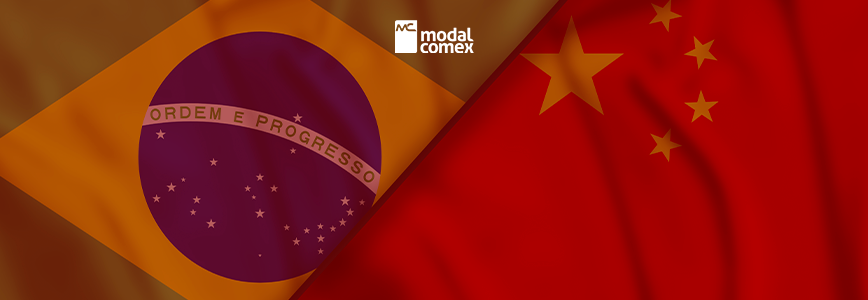Commercial relationship between Brazil and China

Brazil and China have a long history of collaboration since their first contact in 1812. This relationship, which spans over two centuries, has solidified China as Brazil’s main trading partner. On Modal’s blog, we explore the history, the trade relationship, and the historical data that shape this important bond.
What you will find in this post:
- History of the Relationship
- Current Trade Relationship
- Relevant Historical Data
History of the Brazil-China Relationship
The first recorded contact between Brazil and China occurred in 1812, when Queen Maria I of Portugal brought Chinese workers to work on a tea plantation near Rio de Janeiro. In the early 20th century, a new wave of Chinese immigrants settled in São Paulo. In 2004, Brazil officially recognized China as a market economy, although the changes corresponding to the 2009 trade agreement have not been fully implemented.
Despite this, a comprehensive agreement was reached, and a positive personal relationship developed between the two presidents. The holding of the second BRICS summit in Brazil in 2010 marked a proposal to strengthen cooperation between Brazil and China in various areas such as politics, trade, energy, mining, financial services, agriculture, and others.
Current Trade Relationship
Since 2009, China has been Brazil’s main trading partner. In foreign trade, the Asian powerhouse plays a crucial role in Brazil’s trade balance, being the largest buyer and direct investor in the country. The global trade war context has intensified ties between the two countries through meetings and conferences within the BRICS framework.
BRICS: Integration and Cooperation
BRICS, consisting of Brazil, Russia, India, China, and South Africa, is an integration mechanism aimed at strengthening the international influence of its member countries. This group has been fundamental for Brazil’s relations with other emerging economies. The BRICS agenda addresses internal topics such as cooperation, economic growth, and social development, as well as external issues related to trade, environment, security, and poverty reduction.
Between 2009 and 2018, 10 conferences were held, promoting cooperation in areas such as science and technology, trade, education, energy, innovation, health, and transnational security.
Commodity Trade
Diplomatic relations between Brazil and China have their roots in the 19th century but gained priority from the 1990s, reflecting economic changes in Brazil. This period was marked by the expansion of the global economy and the creation of MERCOSUR. In Brazil, monetary policy aimed to link the real to the dollar, facilitating exports. However, due to difficulties in meeting international demand for raw materials, the Brazilian industry underwent a process of deindustrialization, making room for China.
During the following decade, international demand drove prices during the “commodity boom,” establishing Brazil as a significant player in international trade. Brazil’s agricultural production, with a focus on soybeans, oranges, and coffee, holds substantial value in the domestic market. In this context, China has become the main destination for Brazilian exports, benefiting from a trade surplus that reached US$ 58.7 billion in 2019.
Historical Trade Data
Brazilian exports to China are mainly composed of basic inputs, such as agricultural products, poultry, minerals, and oil. Between 2008 and 2018, the trade relations between Brazil and China, as well as Brazilian exports to China, grew significantly, with a 16% increase. However, in 2019, exports to China fell by 1.6%, totaling US$ 62 billion, with notable decreases in soybean, crude oil, and iron ore exports.
Currently, China is the world’s largest industrial producer, with significant export capacity due to advanced technology and the competitive potential of its products, attracting consumers and commercial partners. Between 2008 and 2019, Chinese exports to Brazil substantially increased, reaching a peak in 2014 at around US$ 36 billion, before dropping to US$ 23 billion in 2016.


